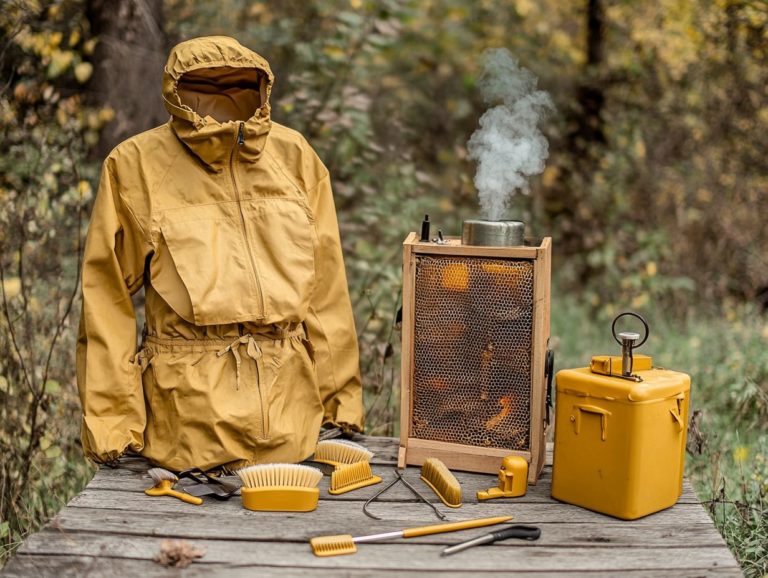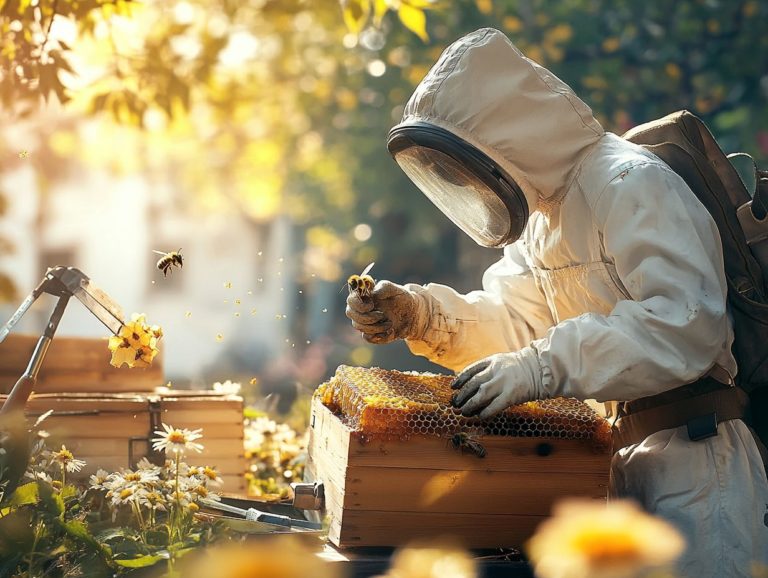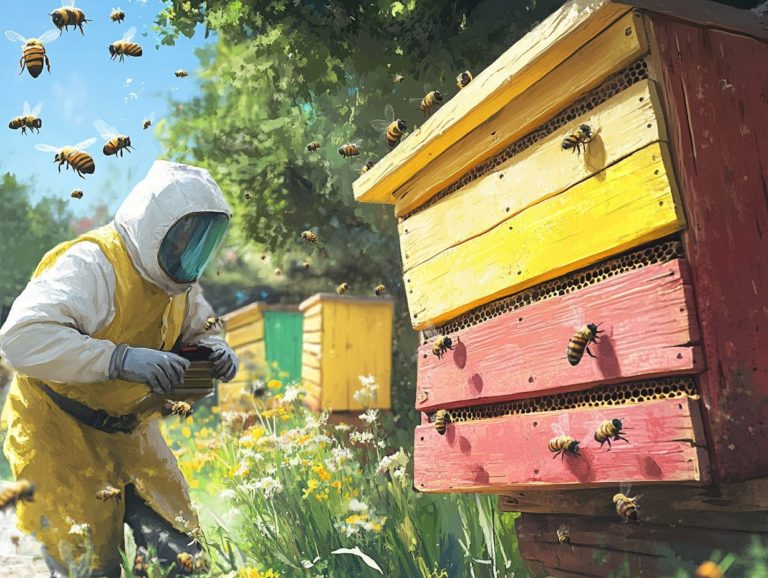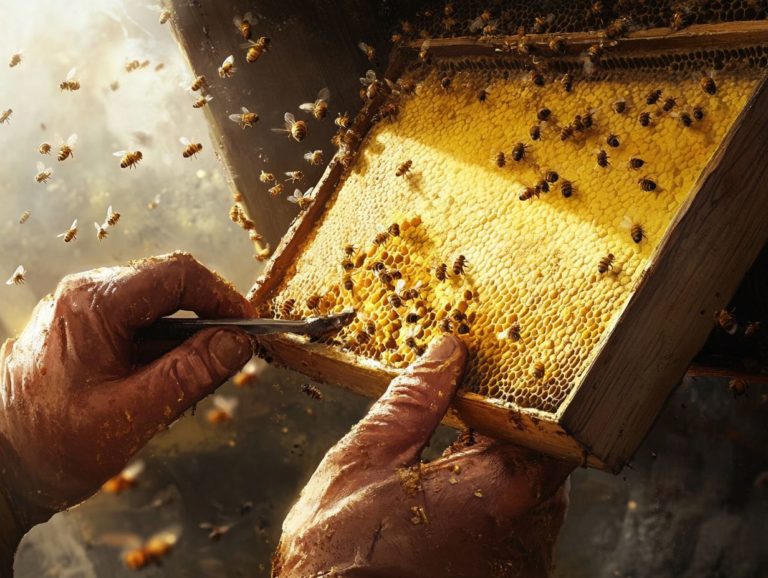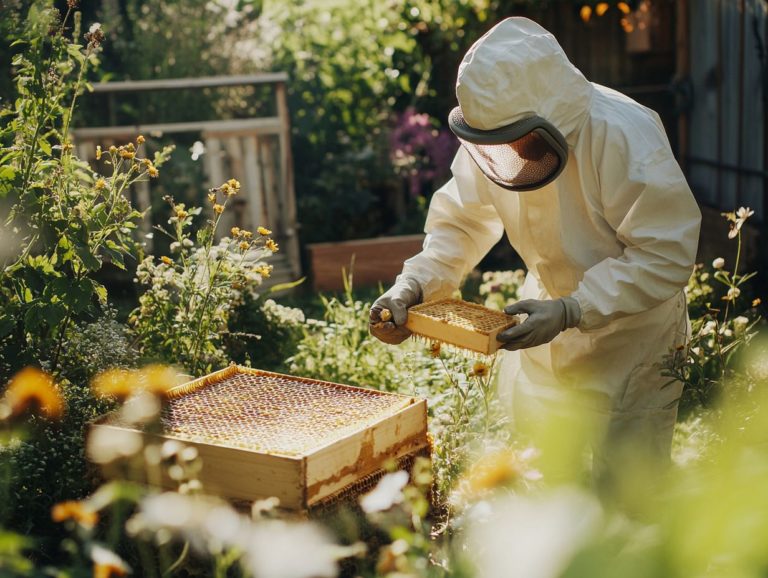Top 10 Hive Management Tips from Experts
Beekeeping is a rewarding yet intricate endeavor, particularly for those just starting out. Successfully managing a hive demands a blend of knowledge, skill, and careful attention to detail. Understanding queen bee management is crucial for overall beekeeping practices.
Get ready to discover ten essential hive management tips from experts that will guide you through the complexities of beekeeping. From grasping the life cycle of bees to ensuring their health and productivity, these insights will equip you with the necessary tools for cultivating a thriving hive. These tips also emphasize monitoring queen health and knowing when to replace your queen to maintain optimal hive conditions.
Whether you re a novice or seeking to refine your techniques, these strategies will undoubtedly elevate your beekeeping journey. Continuous education on beekeeping practices and staying updated with the latest techniques are key to success.
Contents
- Key Takeaways:
- 1. Understand the Life Cycle of Bees and Queen Bee Management
- 2. Provide Adequate Food and Water: Essential Beekeeping Practices
- 3. Monitor and Control Pests and Diseases: Essential Beekeeping Practices
- 4. Properly Place and Orient Hives: Key Beekeeping Practices
- 5. Regularly Inspect and Maintain Hives
- 6. Know When and How to Harvest Honey: Key Beekeeping Practices
- 7. Practice Good Hygiene and Sanitation
- 8. Be Mindful of Weather and Environmental Factors
- 9. Educate Yourself on Beekeeping Techniques
- 10. Join a Local Beekeeping Association
- What Are the Most Common Mistakes Made by Beginner Beekeepers?
- Frequently Asked Questions
- What are the top 10 hive management tips from experts?
- How important is proper hive placement in hive management?
- Why is regular inspection and maintenance necessary for hive management?
- How does proper ventilation play a role in hive management?
- Why is ensuring a steady food and water supply important for hive management?
- What are some effective methods for swarm prevention in hive management?
- How can proper protective gear help with hive management?
Key Takeaways:
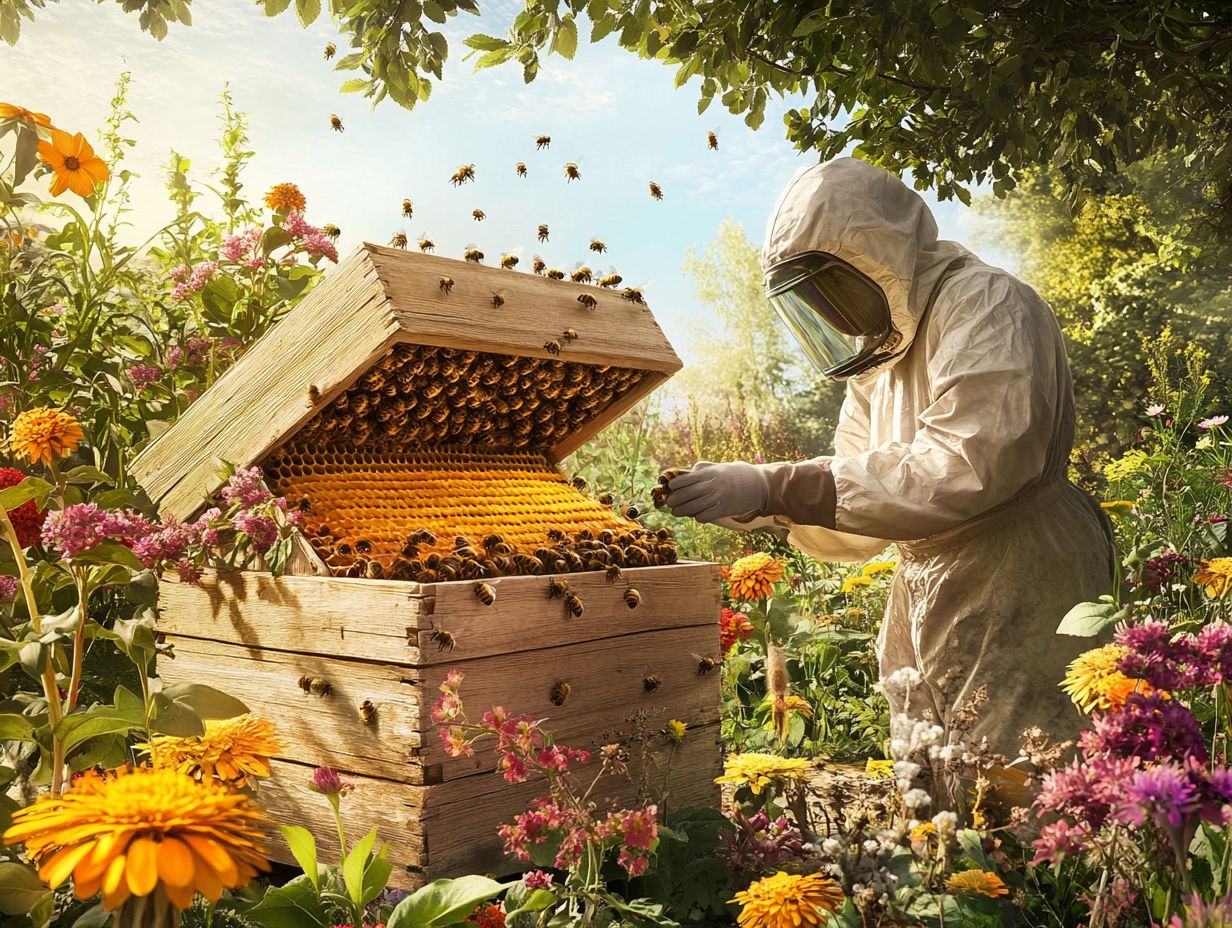
- Join beekeeping associations today to connect with community support and resources.
- Understand the importance of the bee life cycle in hive management and how it affects colony behavior and productivity.
- Provide adequate food and water for your bees to ensure their health and prevent swarming.
- Regularly monitor and control pests and diseases to maintain a healthy hive and ensure colony productivity.
1. Understand the Life Cycle of Bees and Queen Bee Management
Understanding the life cycle of bees is crucial for you as a beekeeper, especially if you aim to optimize your hive management and ensure the health of your colonies throughout the seasons. The importance of queen bee management cannot be overstated.
The lifecycle of honey bees encompasses distinct stages: egg, larva, pupa, and adult. Each stage demands specific care and environmental conditions to flourish. Recognizing the role of the queen bee is paramount, as her health directly impacts the brood pattern and overall productivity of the hive.
As the sole fertile female in the hive, the queen bee dedicates her life to laying eggs, marking the beginning of this intricate cycle. Each egg evolves into a larva, nurtured by worker bees until it transitions into the pupa stage, during which remarkable transformations take place. This process highlights the importance of a vigorous queen, who will produce a consistent and high-quality brood, essential for maintaining your colony’s strength.
Keeping a watchful eye on her well-being is critical. Any decline can lead to diminished hive productivity. By understanding these stages, you not only gain insights into potential issues but also position yourself to intervene promptly, ensuring your colony thrives season after season.
2. Provide Adequate Food and Water: Essential Beekeeping Practices
To ensure the health and productivity of your beehive, you must provide adequate food and water. These resources are essential for the health of honey bees and the overall well-being of the colony. As a beekeeper, it s essential for you to understand the significance of maintaining a consistent food source, including pollen and nectar, especially in early spring when nurse bees begin rearing brood.
These food sources support the development of young bees, boost their immune systems, and foster the growth of the colony. Consider planting a variety of flowering plants near your beehive to guarantee a steady supply of nectar and pollen throughout the foraging season. This is particularly crucial during the months when floral resources are scarce.
Accessible water sources are equally important, especially during dry spells. A shallow dish or birdbath filled with pebbles and clean water can serve as a safe oasis, preventing your bees from drowning. Properly placed water sources can significantly aid in maintaining hive health.
In case of severe food shortages, you might need to supplement your bees’ diet with sugar syrup or pollen substitutes to provide the necessary nutrients. This ensures your bees can thrive until natural food sources become plentiful once more.
3. Monitor and Control Pests and Diseases: Essential Beekeeping Practices
Monitoring and controlling pests and diseases is essential for the sustainability of your beehive. Effective pest management safeguards the health of your colony, boosts honey production, and enhances overall hive productivity. As a beekeeper, you must remain vigilant in spotting signs of brood diseases and managing parasites that could jeopardize your hive s well-being. This involves thorough monitoring of colonies and implementing strategies to control pests effectively.
Among the most notorious offenders are Varroa mites, which attach themselves to bees and drain their vitality by feeding on their bodily fluids. Another significant threat is American foulbrood, a bacterial infection that can wipe out bee populations if not addressed promptly. Awareness and early detection of these threats are critical components of effective pest management. Act quickly to protect your hive from harmful pests; every moment counts!
To mitigate these threats, embrace integrated pest management (IPM), a strategy that combines different practices to control pests effectively. Key components include:
- Regular colony inspections
- Use of screened bottom boards
- Mite-resistant bee stock
Implement chemical treatments only when necessary, while also utilizing non-chemical control methods like drone brood removal and essential oils. Keeping thorough records of pest populations and the effectiveness of treatments empowers you to make informed decisions that promote the long-term health of your hive. Join local beekeeping groups for additional support and resources for managing pests and diseases.
4. Properly Place and Orient Hives: Key Beekeeping Practices
Position your hives wisely for thriving bees and a bountiful honey harvest! Proper placement and orientation of your hives are essential for creating optimal conditions for your honey bees. The right apiary location significantly influences their health and productivity. Factors like access to sunlight, protection from wind, and ensuring dry ground for your hive stand play a crucial role in helping your bees thrive. Temperature control and providing a natural habitat can further enhance hive conditions.
When selecting the ideal apiary site, consider not just sunlight exposure, which helps maintain the hive’s internal temperature, but also the distance from high foot traffic areas. This minimizes stress on your bees, allowing them to forage with less disruption. Ensure there is space around the hives to reduce disturbances and facilitate easy access for maintenance.
Easy access to abundant food sources, such as flowering plants, and a nearby water source are vital for your colony’s sustenance. Orienting your hives to face southeast can enhance foraging efficiency, allowing your bees to bask in the morning sunlight while reducing their exposure to harsh afternoon winds. Positioning a wind barrier around your hives can further protect them from excessive wind exposure.
By creating a calm and suitable environment, you’ll cultivate a more productive and healthy bee colony, significantly boosting your chances of a successful honey harvest. Understanding and implementing these placement strategies are vital productivity factors.
5. Regularly Inspect and Maintain Hives
Regular inspections and maintenance of your hives are crucial for successful beekeeping. These practices empower you to monitor your colonies for any signs of disease, assess brood patterns, and ensure the overall health and productivity of your hives. Handle the bees gently during these inspections to minimize their stress and foster a harmonious environment within the hive.
Conduct these inspections every 7 to 10 days during peak seasons to closely observe the dynamics of your colonies. Pay attention to specific indicators such as the presence of the queen, the vitality of the brood, and any signs of pests like Varroa mites. Monitoring your colonies closely helps you identify issues early and take corrective actions.
Utilizing tools like a queen excluder can effectively manage the queen’s access to certain frames, streamlining your inspections. Consistent inspections not only strengthen your hive but also allow you to take prompt action at the first hint of trouble, enhancing both honey production and colony vitality. Incorporate best practices and organic beekeeping methods to ensure the long-term sustainability of your apiary.
Don’t wait! Start inspecting your hives today to ensure their health and productivity.
6. Know When and How to Harvest Honey: Key Beekeeping Practices
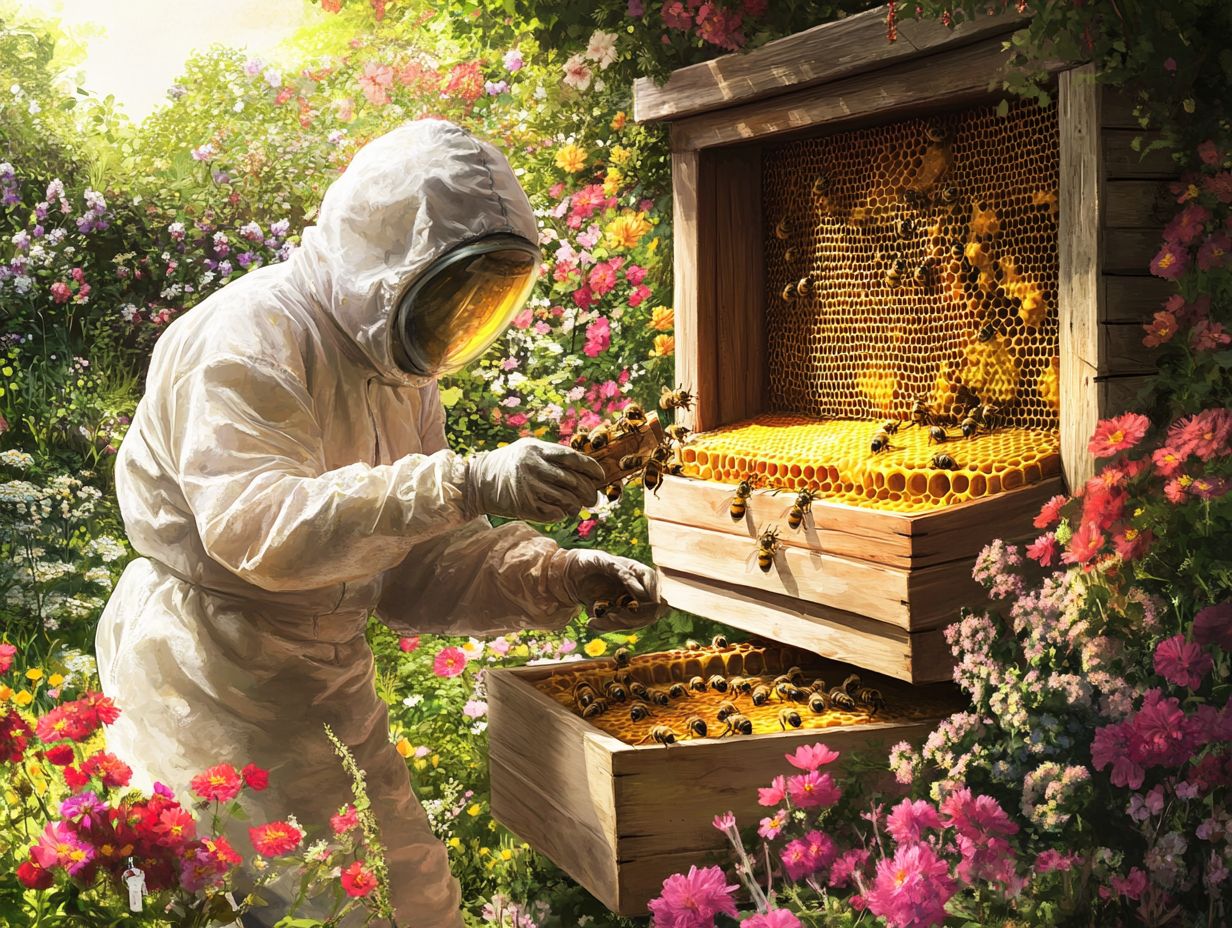
Knowing when and how to harvest honey is crucial. This helps maximize production while keeping your colony healthy.
Watch for signs like capped frames, which show that the honey is ready. Capped frames are those with wax caps that signal ripened honey. Increased bee activity often means there s surplus honey available.
You can choose traditional methods, like a honey extractor, or modern options, like electric extractors. Regardless of the method, always remember to leave enough honey for your bees, especially during colder months.
7. Practice Good Hygiene and Sanitation
Practicing good hygiene and sanitation in your apiary is crucial for keeping honey bee colonies healthy. Clean equipment and effective management strategies minimize the risk of diseases and pests.
Incorporate regular cleaning routines to ensure your tools like hive bodies, frames, and smokers do not harbor harmful pathogens. Use a solution of warm water and mild detergent to wash your equipment, then rinse and dry thoroughly.
Designate specific beekeeping tools for each hive to avoid cross-contamination. Implementing a rotation system allows for adequate sanitization time. By adopting these practices, you ll reduce the spread of issues like Varroa mites and American foulbrood.
8. Be Mindful of Weather and Environmental Factors
Being mindful of weather and environmental factors is essential for effective beekeeping. These elements directly impact the health, productivity, and behavior of your honey bees.
Temperature fluctuations and seasonal patterns influence your hive. During hot spells, bees may become aggressive and less efficient at foraging. Excessive rain can restrict their ability to gather nectar and pollen.
You must manage hive temperatures proactively to keep your bees safe. Provide adequate ventilation or shade to protect against overheating. Ensure your hive stand is placed on dry ground and has a wind barrier to shield from harsh winds.
As the colder months approach, insulate your hives to retain warmth and prevent moisture buildup. Adjust your feeding practices and secure a reliable water source to help your colonies flourish throughout the seasons.
Never underestimate the importance of community support. Local beekeepers often share invaluable insights and resources that can help you navigate these challenges together.
9. Educate Yourself on Beekeeping Techniques
Continuously educating yourself on beekeeping techniques is essential for anyone looking to elevate their skills. This effort secures the long-term success of your hives.
Joining local beekeeping groups provides invaluable networking and mentorship opportunities. Explore many options of educational resources available today.
Books by seasoned beekeepers offer foundational knowledge. Advanced courses can deepen your understanding of how to care for your hives, pest control, and brood rearing.
Online platforms offer many video tutorials and webinars for all expertise levels. By weaving together these diverse resources and actively participating in community discussions, you can share insights, tackle challenges collaboratively, and cultivate a support system that fosters continuous growth and adaptability in your beekeeping journey.
10. Join a Local Beekeeping Association
Joining a local beekeeping association connects you with passionate beekeepers ready to share their wisdom and resources! It fosters a collaborative environment where you can share knowledge and best practices with fellow enthusiasts.
These associations often provide educational workshops, networking opportunities, and access to expert advice, all designed to enhance your beekeeping experience.
As a member, you gain access to a wealth of shared resources, including equipment rentals and bulk purchasing options that can help you save costs and boost efficiency. Mentorship programs present a significant advantage as well, pairing you with seasoned experts who can guide you through the intricacies of hive management.
Engaging in community events not only strengthens your connections within the beekeeping community but also raises awareness about the critical role of bees and pollination, promoting sustainable practices in the process.
In this supportive atmosphere, you can refine your skills while actively contributing to the health of local bee populations and learning about organic beekeeping.
What Are the Most Common Mistakes Made by Beginner Beekeepers?
As a beginner beekeeper, you may find yourself facing a variety of common mistakes that could hinder your success and negatively impact your hives. Issues such as inadequate monitoring of queen health and neglecting essential hive management strategies can lead to problems like brood diseases.
Understanding these pitfalls is crucial for fostering a thriving beekeeping experience and ensuring the long-term health of your colony. It’s important to monitor queen health and be aware of the queen’s role in the hive.
You might often overlook the importance of regular hive inspections, which are vital for assessing queen performance and identifying potential problems such as pests, diseases, or insufficient honey stores.
Many new beekeepers underestimate the critical role of proper feeding during essential seasons, which can weaken colonies if not managed effectively.
To sidestep these traps, developing a consistent inspection routine is key, along with staying informed about the seasonal colony lifecycle and demands on your hive. Continuous learning through local beekeeping clubs or online resources can offer invaluable insights, helping you build confidence and enhance your skills in maintaining healthy hives.
How Can a Beekeeper Prevent Swarming?
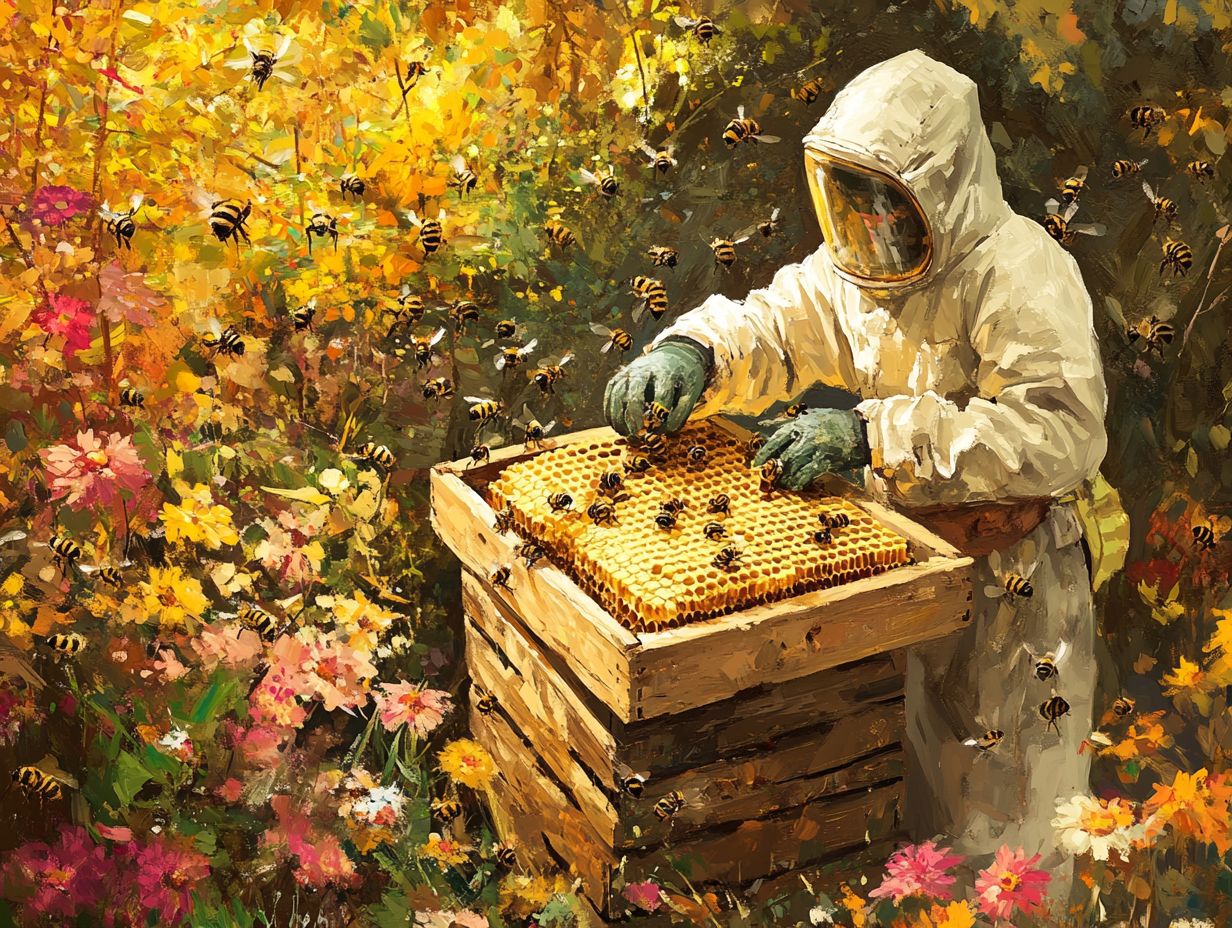
Preventing swarming is a crucial element of effective hive management, ensuring both the stability and productivity of your bee colony. By closely monitoring the health of your queen, understanding seasonal patterns, and, if needed, introducing new queens to maintain a robust brood pattern, you can significantly reduce the likelihood of swarming.
Along with these practices, it’s essential to provide your bees with adequate resources, including food and ample space within the hive. When bees feel cramped or deprived of necessary supplies, they may instinctively initiate preparations to swarm as a survival tactic. Remember to leave space within the hive and practice gentle handling during inspections to minimize disturbance.
Gentle handling during hive inspections is equally important; stressing the bees can trigger swarming behaviors. By employing proactive management strategies such as regularly checking for signs of swarm preparation and implementing effective prevention techniques you ensure that your colony not only survives but thrives.
With diligent care and attention, you have the ability to create a harmonious environment that greatly minimizes the risk of swarming. By implementing these best practices, you support the health and productivity of your hives.
What Are the Best Practices for Wintering Bees?
Implementing best practices for wintering your bees is crucial for ensuring their survival and health during the colder months. With the right hive management strategies, you can maintain optimal conditions and facilitate effective temperature control.
By preparing well in advance, you can equip your colonies with the necessary resources and support to thrive throughout winter. Ensure your colonies have sufficient pollen resources and food sources to meet their needs during this period.
Proactive measures, such as insulating hives with suitable materials, play a key role in retaining warmth. Additionally, ensuring proper food storage like providing enough sugar syrup or candy boards will guarantee that your bees have ample sustenance during the chilly season. Make sure to monitor the nutritional requirements of your colonies regularly.
Maintaining proper ventilation is equally critical; it prevents moisture buildup, which can jeopardize the health of your colony. Beyond these practical steps, seeking community support can significantly enhance your preparedness. Engage with local beekeeping associations for insights and resources tailored to your region.
Sharing insights, tools, and local experiences fosters a stronger network, giving you the power to tackle challenges more effectively during this vital period. Remember to consider the environmental conditions and apiary location for optimal hive placement.
By creating a cooperative environment, you can make a substantial difference in the successful wintering of your hives.
How Can a Beekeeper Ensure the Health of Their Hive?
Ensuring the health of your beehive requires diligent monitoring and the implementation of best practices to tackle potential issues like managing parasites and preventing brood diseases. As a beekeeper, you must prioritize the health of the queen and the overall colony to promote successful hive management.
Regular inspections are vital to this proactive approach. By routinely checking the status of the queen, brood patterns, and stored resources, you can quickly identify any abnormalities. Monitoring for signs of common diseases, such as Varroa mites or American foulbrood, is essential; early detection can significantly enhance treatment outcomes. Consider using a queen excluder to manage the queen’s movement and help maintain a stable brood pattern.
Providing adequate resources, like sugar syrup during dearth periods or ensuring ample forage sources year-round, is key to maintaining strong colonies. Ultimately, by adopting these methods, you foster a thriving beehive, equipping yourself with the knowledge and tools necessary to address challenges effectively. Additionally, consider the productivity factors that can influence honey production.
What Are the Benefits of Using Natural Methods in Hive Management?
Natural methods in hive management offer many advantages. They help enhance the health and productivity of your bee colonies and support sustainable practices.
Organic beekeeping nurtures the well-being of honey bees and cultivates a sense of community among environmentally conscious beekeepers.
By opting for organic treatments to manage diseases and pests, you can significantly reduce your reliance on chemical pesticides that often jeopardize beneficial insects and the environment.
Techniques such as applying essential oils, engaging in a combination of methods to control pests, and fostering healthy biodiversity around your hives can serve as effective preventive measures. Providing a natural habitat for your bees can further support their well-being.
These natural strategies create a stronger bee population and a thriving environment! They also enrich the surrounding ecosystem by encouraging the growth of native plants and enhancing soil health.
Ultimately, these methods contribute to a vibrant habitat that supports both bees and other pollinators, ensuring sustainability for generations to come.
Check out this informative video on effective beekeeping practices!
This video, presented by experts from Galena Farms and the U.S. Department of Agriculture, explores effective beekeeping practices.
Frequently Asked Questions
Learn about hive management tips, beekeeping practices, and more from experts in the field.
What are the top 10 hive management tips from experts?
- Proper hive placement
- Regular inspection and maintenance
- Proper ventilation
- Adequate food and water supply
- Swarm prevention
- Use of proper protective gear
- Maintaining a healthy environment
- Regular pest management
- Proper harvesting techniques
- Ongoing education and learning
Additionally, monitoring queen health and brood patterns, as well as managing parasites, are critical for hive productivity.
How important is proper hive placement in hive management?
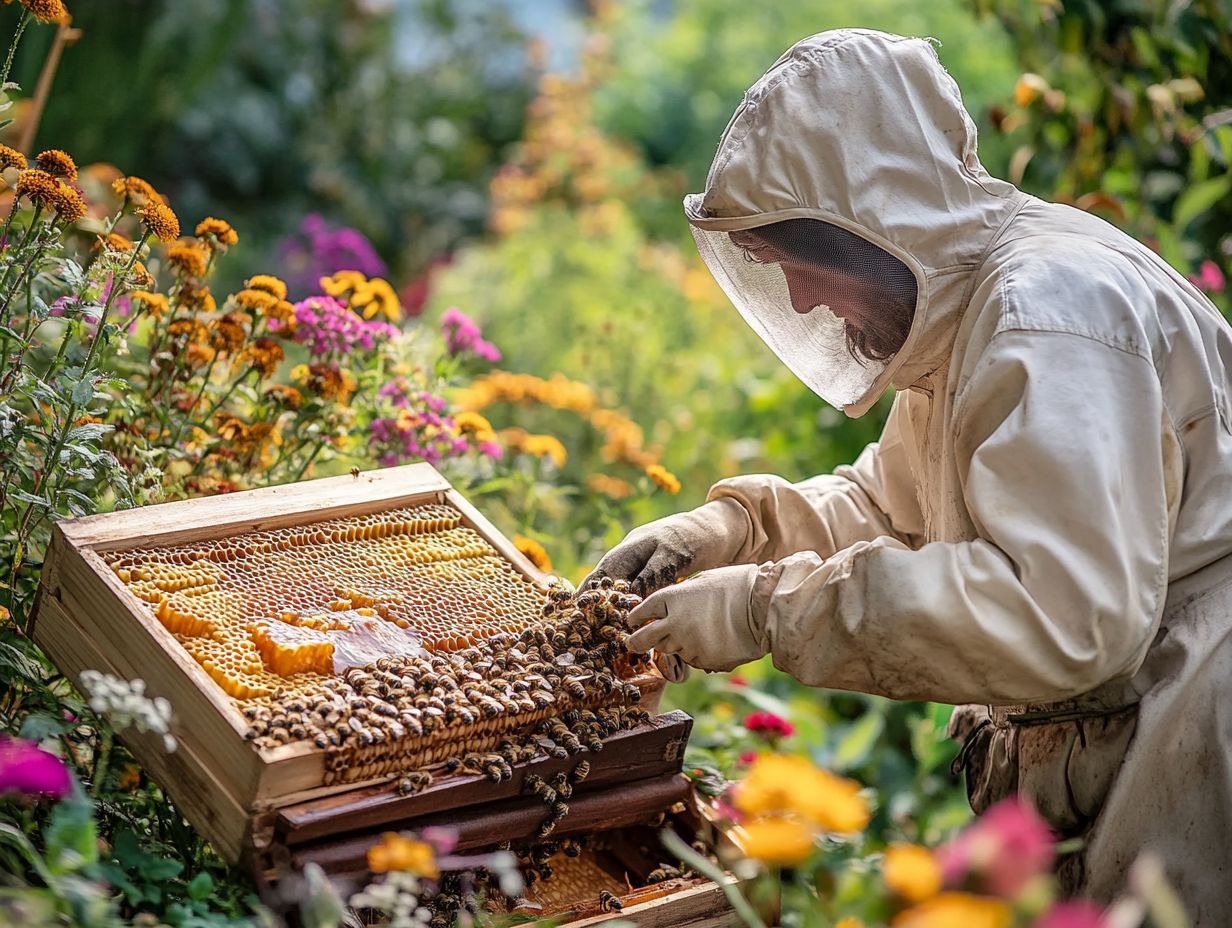
Proper hive placement ensures the health and productivity of your beehive.
Proper hive placement is crucial in hive management as it affects temperature, ventilation, and overall hive health. Hives should be positioned in areas with good sun exposure, shelter from harsh winds, and away from heavy traffic or potential predators.
Ensure the hive entrance faces the morning sunlight, is on dry ground, and has a wind barrier nearby. A hive stand can also help keep the hive dry and off the ground.
Why is regular inspection and maintenance necessary for hive management?
Regular inspection and maintenance are key beekeeping practices.
These practices allow beekeepers to monitor the health of their hive and catch potential issues early on. This includes checking for signs of disease, like brood diseases or pests, and ensuring the hive is clean and free of obstructions.
Monitoring colonies and the queen s role in raising the young bees is also essential.
How does proper ventilation play a role in hive management?
Proper ventilation is a fundamental aspect of maintaining optimal hive conditions.
Adequate ventilation helps regulate the temperature and humidity within the hive, creating a more comfortable and healthy environment for the bees. It also prevents moisture build-up, which can lead to mold and other issues.
Proper temperature control is vital for the health and productivity of the beehive.
Why is ensuring a steady food and water supply important for hive management?
Providing adequate resources is critical for bee survival and productivity.
Bees need a sufficient and steady supply of food and water to thrive. Beekeepers should regularly check and replenish food sources, such as nectar and pollen, and provide a nearby water source for their bees.
Meeting the nutritional requirements of honey bees, especially during early spring and brood rearing seasons, is crucial.
What are some effective methods for swarm prevention in hive management?
Prevent swarming to maintain the stability and productivity of your hive.
Some effective methods for swarm prevention include giving the bees enough space within the hive, identifying and replacing a queen if needed, and avoiding overcrowding in the hive.
Regularly inspect your hive to catch any signs of swarming behavior early!
Use a queen excluder to prevent the queen from laying eggs in specific areas. A queen excluder is a device that prevents the queen bee from accessing certain parts of the hive. Introducing new queens can also help in swarm prevention.
Take preventive measures today to ensure a thriving hive!
How can proper protective gear help with hive management?
Proper protective gear is essential for safe hive management practices.
Beekeepers should always wear proper protective gear when working with their hives to prevent any stings or injuries. This includes a beekeeping suit, gloves, and a veil.
Keep an EpiPen nearby for any severe allergic reactions.
Always practice gentle handling of bees to minimize disturbance and stress.

